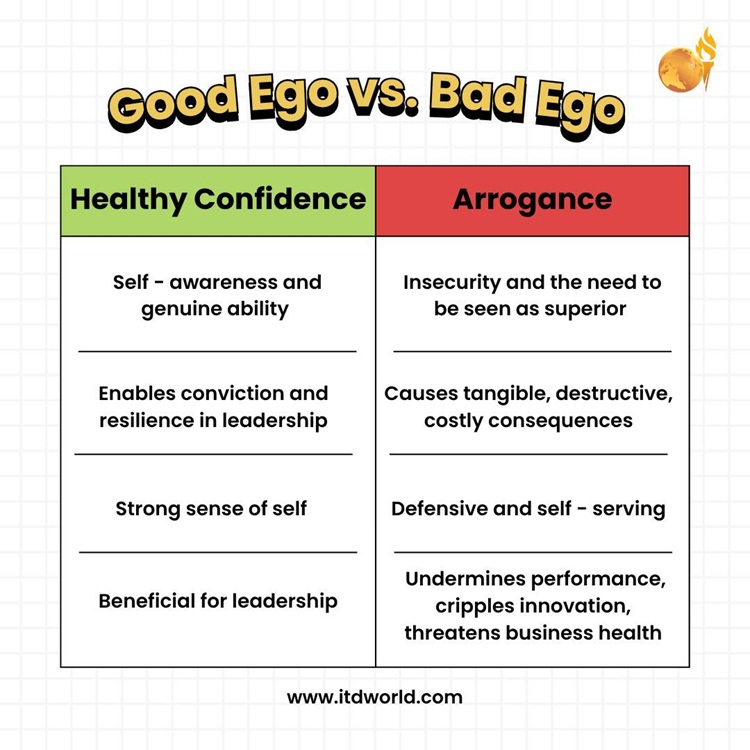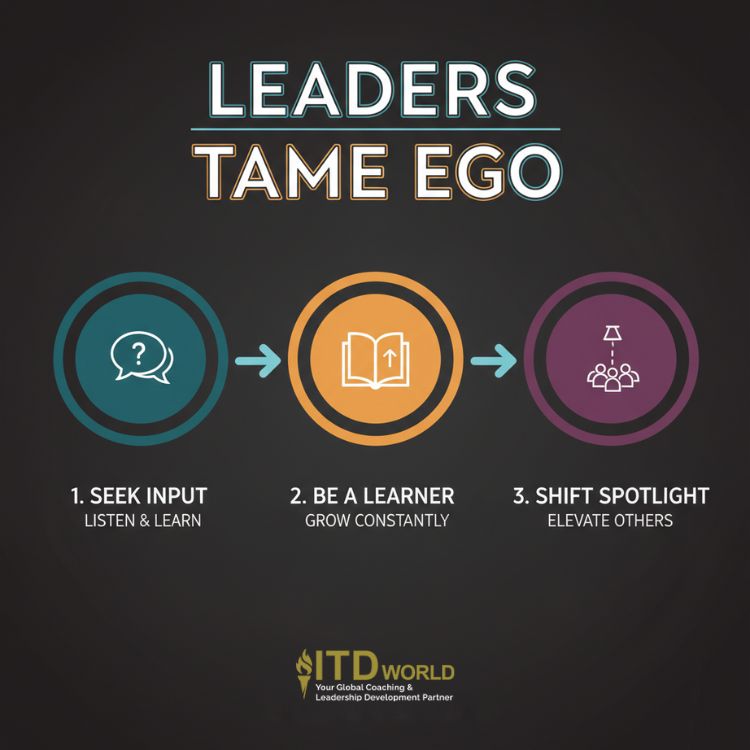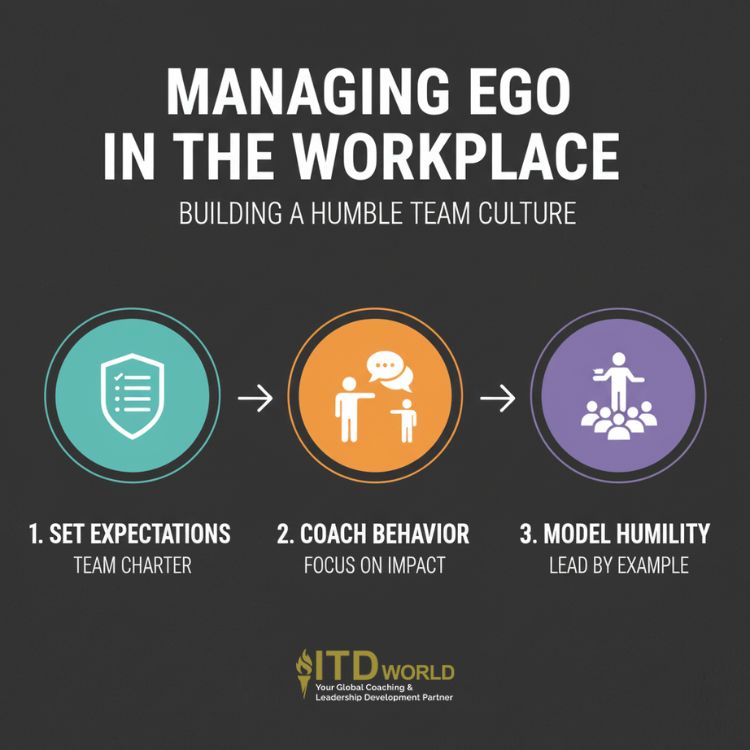Learn about how unhealthy ego in the workplace manifests, its disastrous impact, plus how to manage it individually and collectively.
While often unnoticed, ego in the workplace is one of the most destructive issues plaguing teams today. Far more insidious than a simple personality clash or a disagreement over strategy, unchecked ego acts as a hidden “evil,” subtly eroding trust, stifling collaboration, and ultimately hindering leadership effectiveness.
|
Author: Jonathan M. Pham |
Highlights
- Ego in the workplace refers to an over-inflated sense of self-importance that shifts an individual’s focus from collective goals to self-interest, often manifesting as controlling, defensive, credit-taking, or “know-it-all” behaviors.
- An unhealthy ego, particularly in leadership, fosters a toxic environment that destroys psychological safety and innovation, drives away top talent, and causes poor decision-making by hindering the acceptance of feedback and advice.
- For leaders, effectively managing one’s own ego is crucial for fostering a healthy work environment; this involves practicing humility through actively seeking input, adopting a learner mindset by listening first, and intentionally shifting the spotlight to credit the team.
- To manage ego within a team, leaders must establish clear expectations for collaborative behavior, coach individuals on specific actions rather than labeling personalities, and most importantly, model humility and vulnerability themselves to cultivate a psychologically safe environment.
- From an organizational perspective, it is essential to overcome the challenges of glorifying “hero” leaders, rewarding “winning at all costs,” and a systemic lack of self-awareness by promoting humility, celebrating collaborative success, and investing in systems that foster self-awareness, such as 360-degree assessments and emotional intelligence training.
What is Ego in the Workplace?
In a business context, the unhealthy ego is an over-inflated sense of self-importance that leads to a distorted view of reality. It shifts a person’s focus from achieving the team’s collective mission to protecting their own status, proving their own rightness, and serving their own self-interest.
This is fundamentally different from healthy confidence, which is rooted in ability and self-awareness. The unhealthy ego is confidence that has morphed into arrogance, and it is a primary source of workplace dysfunction.
| Feature | Good “Ego”/ Healthy Confidence |
Bad Ego/ Arrogance
|
| Rooted In | Self-awareness and genuine ability |
Insecurity and need to be perceived as superior
|
| Impact on Work | Enables conviction and resilience in leadership |
Causes tangible, destructive, costly consequences
|
| Nature | Strong sense of self |
Defensive, self-serving
|
| Result | Beneficial for leadership |
Undermines performance, cripples innovation, threatens business health
|

How Ego in the Workplace Manifests
The ego rarely announces itself loudly. Instead, it shows up in a pattern of destructive behaviors that can be grouped into four common archetypes:
- The Controller: Those who desire to be in charge of every detail; as a result, they micromanage projects and withhold information to maintain a sense of power and control over others.
- The Defender: This person is incapable of handling criticism or admitting fault. Their pride makes them highly defensive; as such, they tend to resist constructive feedback, make excuses for failures, and pass the buck by blaming others when things go wrong.
- The Credit-Taker: Those who are primarily focused on their own visibility and advancement. They are quick to take credit for their team’s successes while consistently failing to give recognition to the people who actually did the work.
- The Know-It-All: Those who believe that their ideas are inherently superior. They tend to dominate conversations, enforce their opinions on others, and quickly shut down new ideas before they can be fully explored, stifling creativity.

The above-mentioned behaviors are incredibly common and often go unnoticed; many times, they are even mislabeled as “strong leadership” or “passion.” They can manifest in anyone, and yet they present a particular risk for certain groups:
- Leaders, C-Suites, and high-achievers: Success is a catalyst for ego inflation. The more a person is praised for being “right,” the harder it becomes to admit they are wrong.
- Long-tenured employees: Individuals who have been with a company for a long time are likely to acquire a “we’ve always done it this way” mindset, which makes them highly resistant to change and new ideas.
- Younger generations: A strong desire to prove oneself quickly may sometimes manifest as an over-inflated confidence or an unwillingness to listen to the wisdom of more experienced colleagues.
Given that the ego is a universal human trait, it can surface at any time. This is why cultivating the self-awareness to recognize it – in ourselves and in others – is a critical skill for everyone at work.
The Disastrous Impact of Ego in the Workplace
When an unhealthy ego drives leadership behavior, it creates a toxic environment with measurable negative outcomes:
- Destroys psychological safety & innovation
Ego-driven behaviors – like shutting down new ideas, blaming others for mistakes, and punishing dissent – create an environment of fear. According to research pioneered by Amy Edmondson of Harvard Business School, this lack of psychological safety is the single greatest barrier to team learning and innovation. When people are afraid to speak up, creativity dies.
- Drives away top talent
A recent study by the Society for Human Resource Management (SHRM) confirmed that a poor workplace culture is one of the top reasons employees seek new jobs, costing organizations billions in recruitment, training, and lost productivity. Top performers, in particular, will not tolerate an environment where their contributions are not valued or where they are micromanaged by an insecure leader.
- Causes poor decision-making
An over-inflated ego prevents one from accepting that they might be wrong, thereby denying them the chance to benefit from crucial feedback and expert advice. As strategist and author Robert Greene notes, “Ego clouds and disrupts everything: the planning process, the ability to take good advice, and the ability to accept constructive criticism.”
The ego is not master in its own house.
Sigmund Freud

Ego is the enemy of good leadership
A Leader’s Playbook for Managing Their Own Ego
Recognizing the dangers of ego in the workplace is the first step, but the real work lies in actively managing it on a daily basis. This is not about eliminating ego entirely – a healthy sense of confidence is vital – but about taming its unhealthy, arrogant, and defensive manifestations.
A leader’s ability to manage ego in their organization starts with their ability to manage their own. This inner work is the non-negotiable foundation for building an authentic, high-trust, high-performing team.

-
Practice humility by actively seeking input
An ego thrives in a vacuum of information; humility, on the other hand, thrives on objective truth. The most powerful way to keep the former in check is to consistently solicit feedback to gain an accurate picture of yourself and your impact on others.
Technique: Don’t wait for the annual performance review. Rather, try to regularly ask your team, peers, and manager direct questions like, “What is one thing I could do differently that would make it easier to work with me?” or “What perspective am I missing on this project?” The goal is to make seeking feedback a normal habit. Tools like 360-degree assessment are invaluable for providing structured, multi-source input that can reveal your blind spots.
Read more: Intent vs Impact in the Workplace – How to Close the Gap
-
Adopt a “Learner” mindset
The ego wants to be seen as the “smartest person in the room.” A humble leader, in contrast, is more interested in finding the best solution than in being the source of it.
Technique: In team meetings, make it a practice to speak last, and let everyone else share their ideas and perspectives first. This simple change in sequence forces you to listen deeply and demonstrates that you value the team’s collective intelligence over your own initial viewpoint. It signals that you are genuinely open to the possibility that someone else has a better idea.
-
Intentionally shift the spotlight
The ego craves credit and recognition. For those in leadership positions, their job is to actively fight this impulse and make a disciplined habit of elevating the team.
Technique: It is recommended that you adopt the success equation from renowned executive coach Marshall Goldsmith: “Less me + More them = Success.” When a project goes well, make your praise specific and directed at those who did the work. Instead of saying, “I’m proud of what we accomplished,” try something like, “I’m incredibly proud of Sarah’s data analysis and Tom’s client management, which were the keys to this success.”
Before you are a leader, success is all about growing yourself. When you become a leader, success is all about growing others.
Jack Welch
How to let go of ego in the workplace
Tips for Managing Ego in Your Team
Once a leader has committed to managing their own pride, their next responsibility is to cultivate a psychologically safe and low-ego environment for their team. This involves proactively addressing problematic behaviors when they arise and setting transparent standards for collaborative, respectful interaction.
-
Establish clear expectations
You cannot hold people accountable for behaviors that have not been defined. As such, it is your job to work with the team to establish “rules of engagement” that explicitly encourage humility and collaboration, while discouraging ego-driven actions.
In practice: During a team meeting or offsite, facilitate a discussion to co-create a “Team Charter”, which might include simple, powerful agreements like:
“We critique ideas, not people.”
“We assume positive intent in our colleagues’ actions.”
“We celebrate team wins collectively.”
Once these standards are established, the leader can gently and objectively refer back to them to correct behavior that is out of line.
Read more: Leadership Accountability – Key to Driving Results & Autonomy
-
Coach on behavior, not on personality
When a team member exhibits self-driven behavior, it is crucial to address it directly but compassionately. The key is to focus on the specific, observable act and its impact on the team, rather than labeling the person as having a “big ego.”
Example: If someone consistently dismisses others’ ideas, a leader should discuss it in a private one-on-one. Instead of saying, “You’re being arrogant,” they should focus on the impact: “I’ve noticed that in our last two meetings, when Jane presented her ideas, you immediately pointed out their flaws without first acknowledging their merits. What happens is that it’s making other team members hesitant to share new concepts. Could you try to find something you value in an idea before you critique it?”
-
Model humility & vulnerability
This is, perhaps, the most powerful strategy of all. A leader’s own actions set the tone for what is acceptable and valued on the team. By consistently demonstrating humility, they make it the norm.
In practice: When the team misses a goal, the leader says, “This one is on me. Here is what I learned from this, and here’s how I’ll adapt.” When they don’t have the answer, they respond with something like, “I don’t know, but let’s find out together.” When a team member has a better idea, they say, “That’s a better idea than mine. Let’s go with that.” Their consistent modeling of humility contributes to a psychologically safe environment where team members feel comfortable setting their own egos aside for the good of the team.

Stopping ego at work
Cultivating an Ego-Resistant Culture: Challenges to Overcome
While individual leaders are the front line in the battle against ego in the workplace, an organization’s systems and unwritten cultural rules can either fuel the problem or provide the cure. To create a truly sustainable, low-ego environment, the company needs to address the systemic challenges that allow arrogance to persist and even be rewarded.
- The glorification of the “Hero” leader
Many traditional corporate cultures tend to glorify the image of the lone, heroic leader – the “brilliant jerk” who has all the answers, makes bold unilateral decisions, and drives results through sheer force of will. This long-held archetype makes humility seem weak and undesirable.
Solution: Promote for humility, not just for heroics. The most powerful message an organization sends is in who it promotes. To counter the “hero” myth, you must evolve your promotion criteria to value collaborative and humble leadership.
In practice: When evaluating candidates for leadership roles, give equal weight to their team’s engagement scores and 360-degree feedback as you do to their individual performance metrics. Ask behavioral questions like, “Describe a major success you were a part of. What were the key contributions of other team members that made it possible?” to gauge whether they have a “we” or an “I” mindset.
- A culture that rewards “winning at all costs”
When an organization’s formal reward systems are focused exclusively on individual metrics (e.g., hitting a sales target), it implicitly encourages cutthroat competition, information hoarding, and other ego-driven behaviors required to win.
Solution: Celebrate and reward collaborative success. To foster a low-ego environment, you must shift the institutional spotlight from the individual to the team.
In practice: Rethink your company’s awards and recognition programs. Instead of only having a “Salesperson of the Year,” consider creating a high-profile “Collaborative Team of the Year” award instead. When celebrating a major success, ensure you highlight the contributions of the entire cross-functional team, not just the project lead.
- A systemic lack of self-awareness
The most significant problem with the unhealthy ego is that those who have it are often the least aware of their impact on others. If an organization has no formal mechanisms to provide objective feedback, these destructive blind spots can persist for years.
Solution: Invest in systems that foster self-awareness. The organization has a responsibility to provide its leaders with the tools they need to see themselves clearly.
In practice: Make emotional intelligence (EQ) training a core component of your leadership development curriculum. Most importantly, implement 360-degree assessments as a standard practice for all managers. This provides objective, multi-source data that can break through an ego’s defenses and facilitate the awareness needed for real behavioral change.
Why do you think that great leaders and thinkers throughout history have “gone out into the wilderness” and come back with inspiration, with a plan, with an experience that puts them on a course that changes the world? It’s because in doing so they found perspective, they understood the larger picture in a way that wasn’t possible in the bustle of everyday life. Silencing the noise around them, they could finally hear the quiet voice they needed to listen to.
Ryan Holiday
Ego in leadership
Quotes About Ego in the Workplace
Big egos are big shields for lots of empty space.
Diana Black
More the knowledge, lesser the ego. Lesser the knowledge, more the ego.
Albert Einstein
The less you feed the ego, the stronger you become.
Nikki Rowe
Impressing people is utterly different from being truly impressive.
Ryan Holiday
Those who have subdued their ego understand that it doesn’t degrade you when others treat you poorly; it degrades them.
Ryan Holiday
The greatest leaders are those who are willing to listen and learn, knowing that their ego is their greatest enemy.
Avoid having your ego so close to your position that when your position falls, your ego goes with it.
Colin Powell
Leaders must be willing to put the ship’s performance ahead of their egos.
Michael Abrashoff
Those who know don’t talk. Those who talk don’t know.
Lao Tzu
Pride goes before destruction, a haughty spirit before a fall.
Proverbs 16:18

Ego issues at work
How ITD World Can Help Build a Healthier, High-Performing Culture
Taming the ego and building a culture of humility and psychological safety is not a “soft” initiative; it is one of the most powerful strategic levers an organization can pull to unlock performance, foster innovation, and retain its best talent.
At ITD World, we specialize in enabling leaders and organizations to navigate these complex human dynamics to cultivate healthier, more effective teams. Our solutions are designed to address the root causes of problematic behavior and foster the skills needed for a high-trust culture.
We offer a range of solutions to support this transformation:
- Executive coaching: Our one-on-one executive coaching provides a confidential space for leaders to nurture the crucial self-awareness needed to recognize and manage their own “shadows”. Our experts will work to help process feedback, identify blind spots, and cultivate the humility required for authentic leadership.
- Leadership workshops: Our programs are designed to equip participants with the core skills to manage team dynamics effectively, with a focus on emotional intelligence (EQ), giving and receiving feedback, and conducting courageous, constructive conversations.
- 360-degree & cultural assessments: We provide the objective, data-driven tools you need to see the truth, measure the health of your current culture, and define a clear starting point for change.
- Customized in-house solutions: Last but not least, we partner with you to design bespoke programs that build a high-trust culture from the ground up, helping you align your systems of recognition and promotion with the values of humility and collaboration.
Ready to build a culture of genuine collaboration and sustainable high performance? Contact ITD World today to learn how our solutions can help!
Other resources you might be interested in:
- Gratitude in the Workplace: A Reflection on Its Miraculous Impact
- Gratitude in Leadership: From Words to Actions
- Spiritual Leadership: A Remedy for Today’s Workplace Woes
- Leadership Self-reflection: Leading with Clarity

